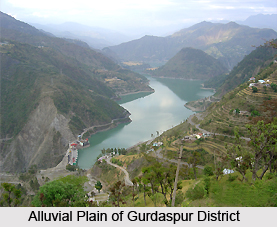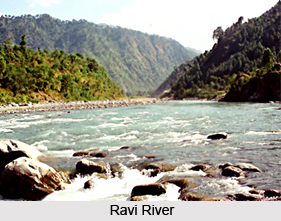 Geography of Gurdaspur District is composed of plains similar to the rest of Punjab plains in structure and surface configuration. Northern most part of the district is in the foot of Shivalik hills. The hilly tract covering the north-eastern parts of Pathankot and Dhar tehsils have typical geographical structures, ranging in elevation from about 381 to 930 metre above sea level.
Geography of Gurdaspur District is composed of plains similar to the rest of Punjab plains in structure and surface configuration. Northern most part of the district is in the foot of Shivalik hills. The hilly tract covering the north-eastern parts of Pathankot and Dhar tehsils have typical geographical structures, ranging in elevation from about 381 to 930 metre above sea level.
From north to south geographical tract consists of three small ranges running in northwest to south east direction - Siali Dhar-Dangahri Dhar range, Dhaula Dhar-Nag Dhar range and the Rata Dhar range. The Siali Dhar-Dangahri Dhar range lies to the extreme north. In its western part Siali Dhar range is about 931 metres above sea level at its highest point and in the eastern part about 959 metres. This range is highly dissected by numerous streams. South of this is situated the Dhaul Dhar-Nag Dhar range which is about 13 km long and at places about 2.5 km wide and has an elevation varying from about 610 to 844 metres above sea level. Lastly, the Rata Dhar range is marking the boundary between the hilly tracts at the dissected undulating plain having an elevation of about 665 metres above sea level. To its south lies an area of about 128 sq kms which is highly dissected and is an undulating plain. Its elevation ranges from about 305 to 381 metres above the sea level.
The flood plains of the Ravi and the Beas are separated from the upland plain by sharp river cut bluffs. They are low lying, with slightly uneven topography. Sand dominates in the soil structure of the flood plains, but it diminishes in both quantity and coarseness in the upland plain. The upland plain covers a large part of the district. Its elevation ranges from about 305 metres above sea level in the north-east to about 213 metres above sea level in the south west, with a gentle gradient of about 1 metre. This is the most important physiographic unit in the district. Geography of Gurdaspur District has the topographic characteristics of Ropar and Hoshiarpur districts.
 Geography of Gurdaspur District includes river system and power resources. Beas River and Ravi River are the two main rivers which flow through the district, both of which originate near the Rohtang pass in Himachal Pradesh. The Chaki Khad is the chief tributary of the Beas in Gurdaspur district. Like other rivers of Punjab the water of the Beas and the Ravi fluctuate from season to season and from year to year. This fluctuating discharge of the rivers does not permit their navigational use. Gurdaspur District possesses a fairly dense network of canals of the Upper Bari Doab Canal system which irrigates most of the area of the district.
Geography of Gurdaspur District includes river system and power resources. Beas River and Ravi River are the two main rivers which flow through the district, both of which originate near the Rohtang pass in Himachal Pradesh. The Chaki Khad is the chief tributary of the Beas in Gurdaspur district. Like other rivers of Punjab the water of the Beas and the Ravi fluctuate from season to season and from year to year. This fluctuating discharge of the rivers does not permit their navigational use. Gurdaspur District possesses a fairly dense network of canals of the Upper Bari Doab Canal system which irrigates most of the area of the district.
There are mainly two seasons - summer and winter. The summer season falls between the months of April to July and the winter starts in November and continues up to March. In summer season the temperature reaches around 44 degree Celsius or even sometimes crosses it. June is the hottest month and January is the coldest one. Most of the rain is received in the month of July. The winter rains are experienced during January and February. The dust storm occurs in the month of May and June. The south-west monsoon generally arrives in the first week of July and continues up to the end of August. 70 percent of the rainfall occurs during this period. The average rainfall of the district is 875.4 mm. The rainfall in Gurdaspur District is greater in the sub mountain parts and it decreases rapidly towards the southwest.
Vegetation varies in Gurdaspur District depending on the soil, topography and elevation. Geography of Gurdaspur District mainly includes loamy soil with clay content below 10 percent. Soils of this district contain small quantities of lime but the magnesia content is high. They are well supplied in potash and phosphoric acid but the quantities available are low. The agriculture is dependent to a large extent on the nature of its soils which in turn, is influenced materially by climatic factors. Further, the soil of the district is quite alluvial and fertile. The minerals found in the district are building stones, foundry sand, lime stone, ochre, fullers-earth, etc. Brick-earth is found in plenty through out the district.



















